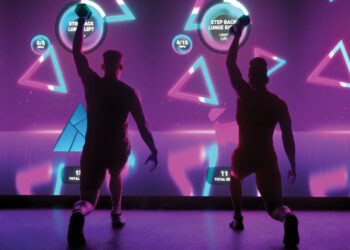Having Group X, small group training (SGT) and mind/body programming is necessary in order to be a well-rounded health club. However, not having sports performance programming can cause you to leave out a key group of members in your gym: athletes.
One way to offer sports performance programming successfully is through individualization. “Make sure each athlete gets the program he or she needs,” said Steve Hendry, the personal training manager at Chelsea Piers Athletic Club, with locations in New York and Connecticut. “Different athletes have many factors that can determine what they need — training age, biological age, sport, limb length, joint angles and injury history, just to name a few.”
However, Hendry said coaches should think generalization before specialization. Athletes need the fundamentals before trying anything advanced.
The three-location club offers a few main types of sports performance training: CP360 for their youth sports teams, individualized one-on-one training, and SGT for the “corporate athlete.”
A key to success with this type of programming is building the right culture, which includes everything from general atmosphere to the details. “Create an environment that promotes healthy competition and social interaction,” explained Hendry. “Knowing your athletes’ favorite band is just as important as knowing how much they bench. This will help with buy-in and training consistency.”
Brian McClelland, the tri club director for Chicago Athletic Clubs, agreed culture is an important element. “Creating a community and promoting that community has been a significant point of difference for us,” he said. “It’s helped us create positive word of mouth and awareness.”
One way to create a great culture is through the coaching and training of your staff. McClelland said it is vital to have an amazing coaching staff you can trust to manage the program and facilitate classes and training. He went on to explain it is just as important to support the coaching staff with necessary materials and educational opportunities to help them grow.
Chicago Athletic Clubs has two core sports performance programs: a Masters Swim Program and Triathlon Club. Both programs compete on the local and regional levels, and to some degree, at the national level as well. “Our Masters Swim program is offered at multiple clubs here in Chicago and has practices two-plus times per week,” said McClelland. “They participate in local and regional meets and also in various social events throughout the year.”
The Triathlon Club offers up to three coached practices each week, and athletes train for anything from Sprint triathlons to IRONMAN races. Chicago Athletic Clubs has also developed RunClub, allowing members to train for everything from a 5K to a marathon. This newly added program has three coached practices a week and is offered quarterly, depending on the races the participants are running.
After deciding on your programs, creating a great culture and hiring the right staff, it is crucial to market your program successfully, especially if you cater to high school or college students. “Sell the athletes, pitch the parents,” said Hendry. “You have to convince the athlete they want to be there and will thrive as a result of seeing you. Then you need to get mom or dad to open the checkbook. Don’t waste your time marketing to high-level teams. They will seek you out based on reputation.”
Hendry explained your athletes are your biggest billboard, so make sure results show. “If you haven’t proven yourself yet, no college or pro team will send you their athletes based on a well-written email or marketing campaign,” he said.
At Chicago Athletic Clubs, marketing involves hitting the pavement. “We take our brand with us to events and races,” said McClelland. “For example, we provide our Triathlon Club athletes with T-shirts, branded triathlon gear, etc. to wear at races and events, and we take our tent with us to help showcase our team.”
Additionally, Chicago Athletic Clubs has a network of clubs throughout Chicagoland, and it has been an advantage for them to have hundreds of members to be able to market to and communicate with. More members lead to more opportunities to sell sports performance programming. “We also host events at our locations to assist in gaining visibility to athletes outside our gym community. Those have helped us gain more notoriety and, in many cases, new members to the club,” explained McClelland.
If you are looking to improve your club’s sports performance programming, Hendry recommends establishing a solid relationship with sports coaches. “Make sure you introduce yourself and include them in the process,” he explained. “Let them know you will be working with their athletes and ask for feedback on what they would like to see improvement on. Always remember the well-being of their athletes is important to them.”
Overall, when it comes to designing your sports performance program, Hendry said not to over-complicate things. The best training can be the simplest. “Remember, the strongest people in the world got that way by squatting, and the fastest people in the world got that way by sprinting,” he said.










